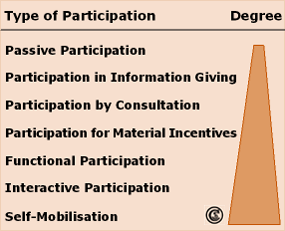Participation
Watershed Management relies on participation of the population in planning, management and implementation as well as monitoring of project activities (Förch and Schütt 2004 b; Tidemann 1996).
Participation means the involvement of interest groups, political decision makers and local organisations in decision making processes and their articulation of interests in those (Farrington and James 1998; Fürst and Scholles 2001; Rauch 1998).
Participation has become a basic principle of Watershed Management since it has been recognised that without participation of the beneficiaries of project activities the endeavours often failed (Förch and Schütt 2004 b). The participation of the population, however, may
- create interest in the process and motivation for the intended activities;
- increase the prospect of institutional and environmental sustainability of the project;
- result in acceptance of responsibility by the population (EC 1998);
- enhance the building and strengthening of democratic structures (Fürst and Scholles 2001).
Participation can take different forms and varying degrees (see figure) (Dulani 2003). As WM builds on participation, it is, furthermore suitable for providing a framework for the utilisation of traditional social structures and traditional knowledge for development (Förch and Schütt 2004 b).
Participation may sometimes difficult to put into practice as it implies changes in decision making processes that are deeply rooted within societies (Rauch 1998). However, this may not impede genuine efforts to involve population. Several participative methods such as Participatory Rapid Appraisal (PRA) are available therefore.
The local population plays a major role, but is not the only actor or have the sole responsibility for natural resources. Rather, the key to success is the interplay between local population, local organisations and the state (Farrington and James 1998). Economical interests and opportunities of the resource users are always taken into consideration and tried to improve (economical aspects) (Förch and Schütt 2004 b). Participation of the stakeholders is especially crucial in selection and implementation as well as maintenance of soil and water conservation measureswhich are topic of the following pages.
